Are Watercolors Toxic ? (The Truth about Toxic Watercolor Pigments)
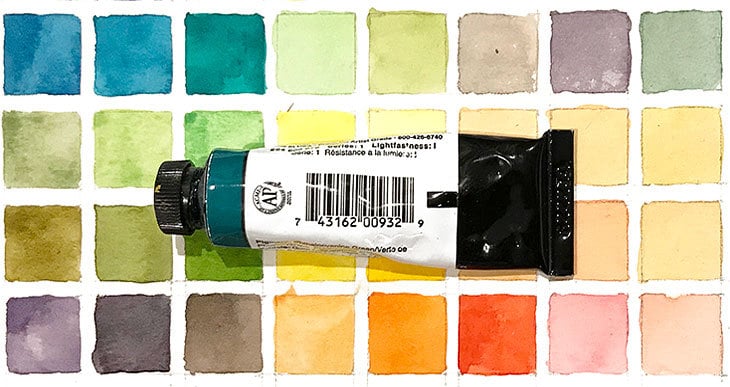
Recently an artist asked me about the toxicity of watercolor paint. It’s true… As artists we should be aware of ecological and health considerations like this. And although I’m not an expert, I thought I could gather together some information to help others interested in this aspect of watercolor painting.
So, is your watercolor paint toxic?
The quick answer is that the majority of watercolors are classified as having “no substances in sufficient quantities to be toxic to humans”. Watercolor paints generally have a low toxic index, but the level of toxicity can vary depending on the pigments used in the paint ingredients.
Well known paint manufacturers conform to standard practices for labeling art materials and the majority of watercolors are labeled as an “Approved Product” which means that they “contain no materials in sufficient quantities to be toxic or injurious to humans”. However a few paints are labeled with a “Cautionary Labeling” seal, which means they are “not hazardous if used correctly”. More about this later…
Just because watercolor paints might contain toxic substances does not mean you should stop painting ! We are all exposed to pollutants in some form or another as we go about our daily lives. The best response is to be aware of any risks and develop good painting habits when you use watercolors !
My own personal approach to watercolors is to use some common sense rules…
Are watercolor paints toxic?
Well… I think the answer to that depends.
The thing is, even if most watercolors are labeled as approved products, repeated exposure to very small amounts of toxic ingredients can have a cumulative effect over a long period.
Given that watercolors potentially have a low level of toxicity but not in sufficient amounts to be toxic to humans, we should perhaps ask ourselves different questions. Things like, “how often do I paint?”, or “what habits should I adopt when handling watercolors?”.
I tend to approach the toxicity of paints with just a few common sense rules.
- Don’t eat or drink when you’re painting.
- Only use dedicated plates or palettes for mixing paint
- Rinse brushes in dedicated jars
- Read the labels of your paints to identify those that require caution.
- If you’re messy, consider wearing protective clothing
- If you paint very often, consider wearing gloves
- Don’t lick your brushes !
- And don’t get your rinse water mixed up with your cup of tea !
You’d be surprised what bad habits we humans can pick up, so developing good habits for safety in the artist studio is probably the best approach.
I have nothing against using an ordinary plate for mixing up watercolors, but once I’ve decided to use it for that purpose, it stays in my studio and isn’t used for anything else. The same thing for rinsing brushes. I use glass mason jars. They’re non porous and easy to clean. And they’re mine ! Nobody else gets to use them for making smoothies !
I don’t bother with gloves but I do know some artists who use them. I quite happily squeeze out my brushes with my fingers so I end up with paint on my hands. So maybe I should consider it…
If you paint almost every day, and you’re concerned about the toxic effects of paints, I suggest using cotton gloves which you can just re-use after washing (Amazon link). Keep in mind, latex and nitrile gloves are non-biodegradable.
Is Watercolor Paint Toxic to Dogs, Cats & Pets ?
In the same way that you probably shouldn’t lick your watercolor paints, make sure your dog doesn’t eat them either !
If your cat accidentally lies in your watercolor palette, wash off the paint before they can lick it off. Similarly, I know dogs that will eat anything. Yep… I do mean anything. So don’t leave your tubes, pans or open palette in a tempting location for pets.
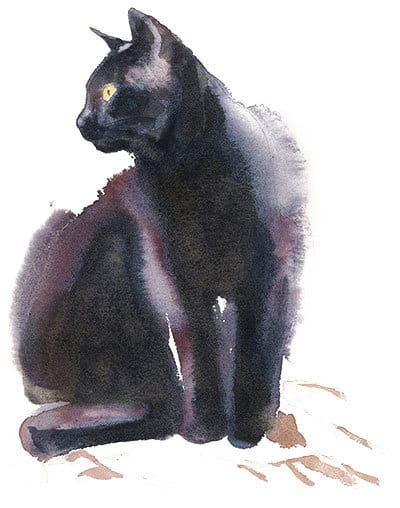
Understanding Watercolor Toxicity Labeling
Look for artist watercolor paints which conform to ASTM D4236 and D5067 which means the paint provides health information as recommended by the “American Society for Testing and Materials”.
The ASTM D4236 is a “Standard Practice for Labeling Art Materials for Chronic Health Hazards”. These guidelines require paints to be labeled toxic, or potential health hazards.
It means that any potentially toxic ingredients in the paint have been clearly labeled on the packaging.
Most paints are labeled “ACMI AP” which means they are an “Approved Product”
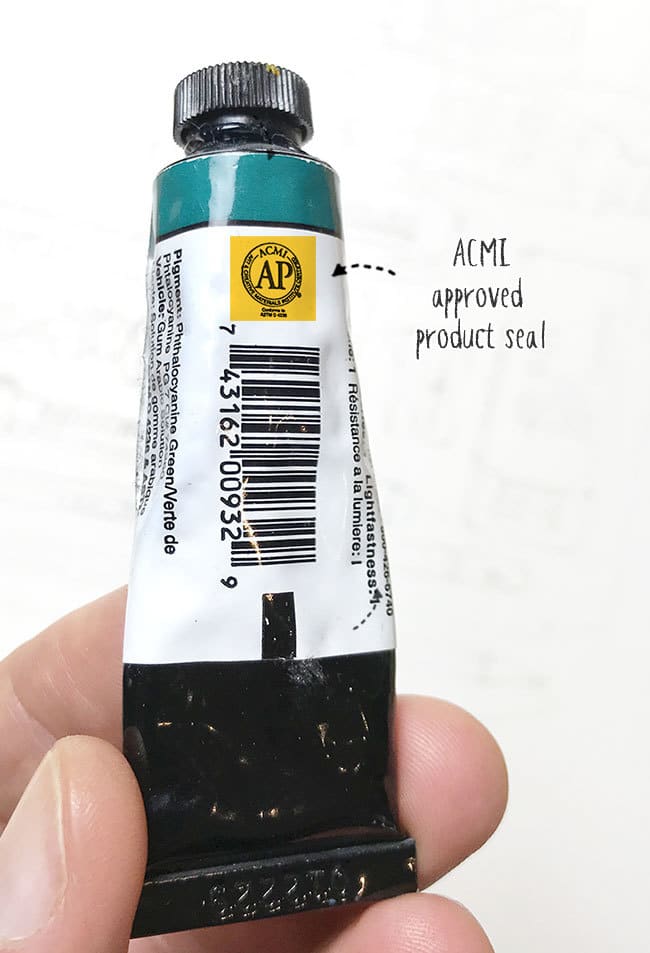
This seal of approval is awarded by the “Art and Creative Materials Institute” (ACMI).
The ACMI is an international association of art material manufacturers which seeks to promote safety in art products through its certification program. They have their own Advisory Board composed of leading toxicological experts who review issues of toxicity in art products.
An “Approved Product” seal “identifies art materials that are safe when used as intended and that are certified in a toxicological evaluation” that “they contain no materials in sufficient quantities to be toxic or injurious to humans, including children”.
By the way, I’m glad they clarified the bit about children – I wasn’t sure if they’re considered humans 🙂
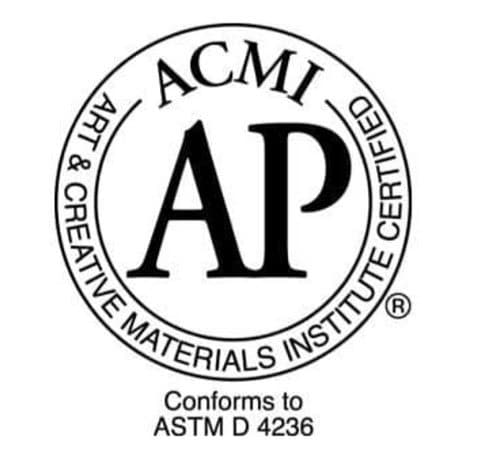
Some paints are labeled “CL” which means “Cautionary Labeling”.
A “CL” seal “identifies products that are certified to be properly labeled for any known health risks and with information on the safe and proper use of these materials”. “Products with this seal are not hazardous” but “these products should never be given to children in grade 6 or lower”. (For us non-americans, grade 6 corresponds to 11 years old).

You can read more about this on the ACMI website
A Concrete Example of Toxicity Labeling – Daniel Smith
A lot of you know that I have a preference for Daniel Smith watercolors. I decided to do a quick exercise and look up the toxicity labeling of what I consider to be the most useful paints in my watercolor palette. These are the colors I currently recommend as a minimal palette which allow you to mix a large range of different color appearances.
Just to explain, this table includes the paint name used by Daniel Smith, and the pigment identification number. Then I’ve included the ACMI seal (remember AP = approved / CL= cautionary). And the final column includes “Proposition 65” which “requires businesses to provide warnings to Californians about significant exposures to chemicals that cause cancer”.
Colors that contain a chemical known to the State of California to cause cancer will have a ‘YES’ under the Proposition 65 heading:
|
Paint Name: |
Pigment number: |
ACMI Seal: |
Proposition 65: |
|---|---|---|---|
|
PY175 |
AP |
NO | |
|
PY65 |
AP |
NO | |
|
PB15:3 |
AP |
NO | |
|
PB29 |
AP |
NO | |
|
PV19 |
AP |
NO | |
|
PR255 |
AP |
NO | |
|
PG7 |
AP |
NO | |
|
PBr7 |
AP |
NO | |
|
PB29, PBk 9 |
AP |
NO |
(Please note: the links above lead to jackson’s Art Store – If you use these links you will benefit from a 10% reduction on your first ever order).
As you can see all of these paints are considered approved products and contain no cancer causing chemicals.
I recommend you look up your own paint labels, just so you’re aware of the toxic characteristics of your watercolor palette.
You can read the full material safety list of Daniel Smith paints here…
(Look for the color information at the very end of the document which shows whether a hazardous ingredient is used and gives the label “AP” or “CL”)
How to Dispose of Watercolor Paint Water
For rinse water, considering that most paints are labeled with low levels of toxicity, I simply pour rinse water in the sink.
I consider that grey-water like this gets filtered, and paint pigment particles should be sufficiently large for them to be filtered out in the early stages of the cleaning process.
From an environmental point of view I would keep a couple of things in mind.
I’ve heard an environmentalist say that you probably pollute more by taking your car to go grocery shopping than by tipping watercolor rinse water down the drain.
Also, I would be more concerned if I were using acrylic paints. The binders used in watercolors like gum arabic are natural substances, but acrylics use plastic binders.
Finally, if you’re really concerned about putting rinse water in your sink, you could consider watering your flowers with it ! I’ve heard a lot of watercolor artists claim that the flowers actually benefit from the minerals in some of the paint ingredients ! However, I would maybe avoid watering the vegetable patch!
Cadmium Watercolor Toxicity
If you’ve been painting with watercolors for a while you may have heard artists repeatedly being concerned about “cadmium” paints. But why is this particular pigment the center of so much fuss?
Cadmiums are used to produce colors ranging from pale yellow to oranges and deep reds and generally produce a very vivid color appearance which is why they are so appreciated by artists.
In December 2013 Sweden called for a ban on the use of cadmium pigments in paints, claiming that artists were polluting when they rinsed their brushes in the sink. The theory was that cadmium would end up in sewage which was then spread onto crops and thereby causing pollution. The counter argument claimed that the source of cadmium pollution probably came from nickel-cadmium batteries being dumped into landfills. In 2015 the European Union officially rejected Sweden’s proposal, stating that “the presence of cadmium in artists’ paints does not present an unacceptable risk to human health”.
Studies have shown that cadmium pigments can be toxic if inhaled or ingested.
It’s true that Cadmium and other metals like cobalt and nickel are toxic. But I’ve read that cadmium, for example, is mostly dangerous in powder form. During the paint manufacturing process cadmium is amalgamated with the binders. This process renders the cadmium insoluble in water, which greatly limits absorption by the human body.
Alternatives to cadmiums are called cadmium hues. A “hue” is an imitation of an original organic or mineral pigment. They are often created by paint manufacturers as an alternative to the pigment based paints.
For example, Winsor and Newton recently developed a range of “cadmium-free” watercolors, which are considered to “provide true parity in color and performance to genuine cadmium paints”.
Here are a few examples (links go to Amazon):
- Winsor & Newton Cadmium-Free Red
- Winsor & Newton Cadmium-Free Orange
- Winsor & Newton Cadmium-Free Yellow
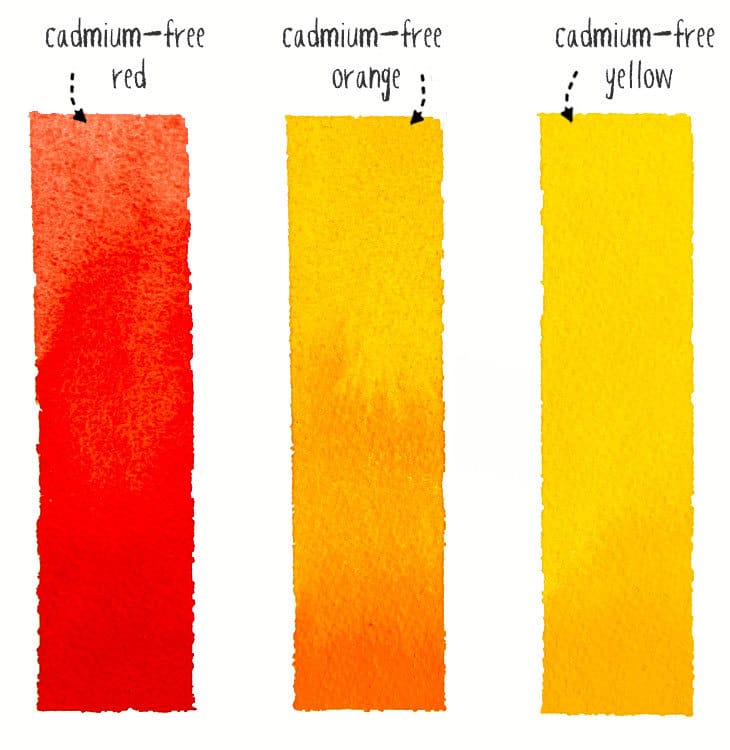
These are an interesting commercial alternative to cadmium paints which are often labeled with a “Cautionary Labeling” seal.
I’ve never tried them – But I’m sure I’ll give them a go one of these days !
Toxicity of Watercolor Paint for Artists
I hope you now have a better understanding of the issue of watercolor paint and toxicity. With a few good habits and a bit of prudence you can continue to enjoy watercolor painting.
Remember… Don’t drink your rinse water. Don’t lick any brushes. And above all, have fun painting!
Disclaimer: This article proposes a common sense approach to the potential of toxic ingredients found in art materials. I am not a health expert. The content of this article is for information only. I give no assurance regarding the accuracy or applicability of the content herein. You are responsible for your own health and safety. I encourage you to do your own research if you have any concerns.

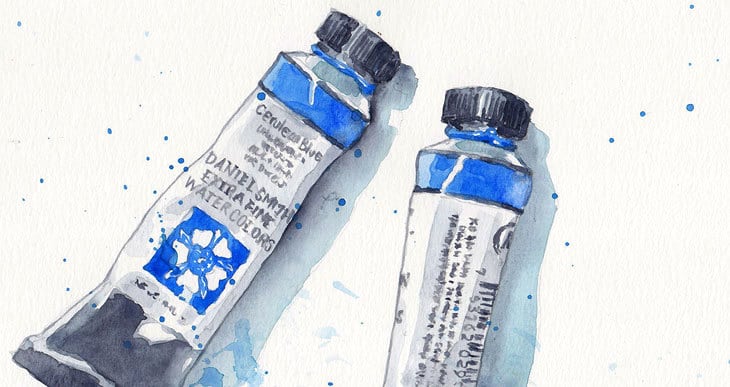


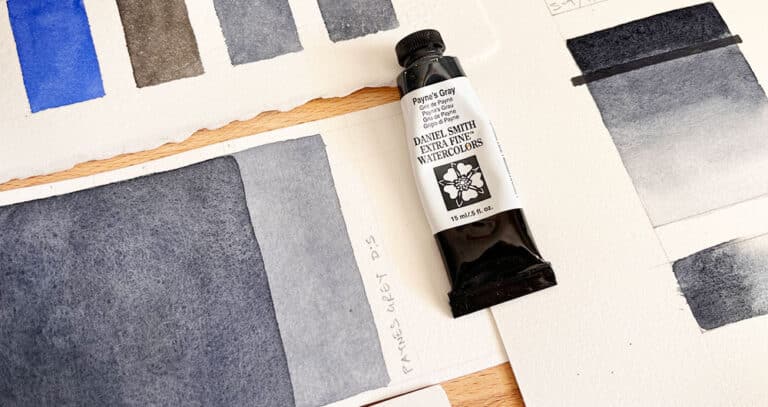
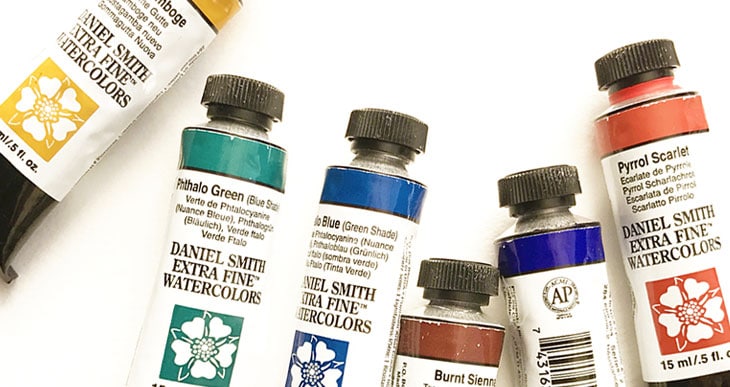

This was very helpful information and exactly what I was looking for today. Thank you!
Just exactly what i wanted to know, Anthony! Thanks for your info in a common sense approach. You did not mention Cobalt colors, so I am thinking they are probably about like the Cads. -? i will do some research on my own, but thanks so much for your leg work that got me going!! Peace, be well, God bless….
As I sit in my garden reading your email I look round at the privet hedges (can cause allergic reactions and asthma) the beautiful cascading blossoms of the laburnum (seeds highly poisonous) The angel trumpet tree ( every part of which is highly poisonous) the rhubarb is doing well but for heavens sake don’t eat the leaves. It makes you wonder how the human race has survived for so long.
?? Myfanwy
Super informative article! Thanks for taking the time to do all the research! You rock, Anthony! 🙂
On a related and non-related note, I, too, wasn’t positive kids were actually humans. 😉 To me, they’ve ranged from little Goblins to little Monsters depending on if it was snack time or dinner time.
Although, I’ve been known to turn from human form to Cake Monster during what we refer to as, The Birthday Season, in my husbands family (from July 1st through Nov. 18 we have, at least, 2 birthdays per month) that are celebrated, no matter how old you get, each year with cake and ice cream. Birthday Season = best season of all seasons 😉
Hi Amanda
You’re making my mouth water with all that cake !
🙂
Thank you for this info…I’ve been wondering about the cadmium colours!
Very informative with a touch of humor. Thanks
So, the honey’s not there just to taste good?
🙂